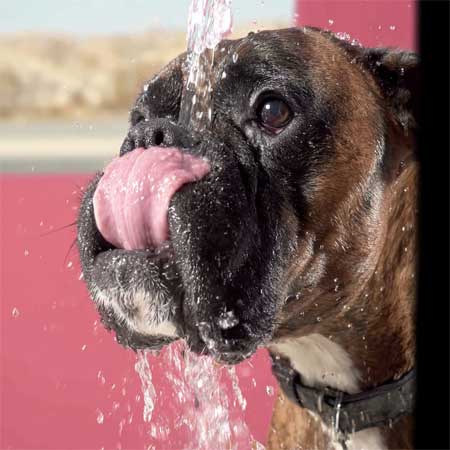How to Prevent Heatstroke in Boxer Dogs
How to Prevent Heatstroke in Boxer Dogs: Summer Safety Guide

Why Boxers Are Prone to Heatstroke
Boxers are loving, playful, and energetic, but they belong to a group of breeds known as brachycephalic dogs — meaning they have short snouts. This unique skull shape makes it harder for them to pant efficiently, which limits their ability to cool down. Combined with their short coat and muscular build, Boxers can overheat quickly if not monitored carefully during warm months.
Unlike dogs with long muzzles, Boxers can’t pant as effectively, making them overheat quickly in hot weather. Add their high energy levels and short coat, and you’ve got a pup that needs extra care in summer!
Heatstroke vs. Sunstroke in Boxers
Heatstroke is a critical condition where your Boxer’s body overheats because its natural cooling system fails. Sunstroke is a type of heatstroke caused by direct sun exposure affecting the brain. Boxers, with their short snouts, are especially at risk.
A Boxer’s normal body temperature is 38.3°C–39.2°C. If it rises to 40.5°C or more, act fast — at 41.2°C–42.7°C, multiple organ failure can occur. Never leave your dog in a stuffy car or hot room, even with windows cracked!
Signs of Heatstroke in Boxer Dogs
To help your dog, you first need to know the signs that indicate this dangerous condition.
Heatstroke is a broader term, so we’ll focus on its manifestations, as the symptoms of both sunstroke and heatstroke are quite similar.
So, how does heatstroke manifest in dogs?
- Panting, difficulty breathing, rapid breathing
- Hypersalivation (excessive drooling)
- Lethargy, apathy
- Exhaustion
- Loss of appetite
- Disorientation, slow reactions
- Impaired coordination
- Elevated body temperature
- Reddened gums
- Vomiting
- Diarrhea
- Loss of consciousness
- Seizures
If your Boxer shows any of these signs, act fast—heatstroke can be deadly!
If your pet only shows the mildest of the listed symptoms, such as lethargy, loss of appetite, or panting, and their overall condition isn’t worsening, then it’s most likely not sunstroke or heatstroke, but rather they are simply suffering from the heat.
Older Boxers, overweight dogs, those with heart or respiratory issues, or dogs in muzzles are at extra risk. Always watch your dog for these signs on hot days!
First Aid for Heatstroke or Sunstroke in Dogs
Heatstroke can lead to brain swelling, kidney failure, gastrointestinal bleeding, and abnormal blood clotting, which can be fatal. That’s why you need to contact a vet immediately!
Heatstroke and sunstroke require urgent medical attention!
The sooner your pet receives help, the higher their chances of a quick recovery with minimal or no long-term health consequences.
So, what should you do right away and while you’re on the way to the vet?
- Immediately move your dog to a cool, shaded area.
- Ensure a continuous airflow around your dog to help increase heat loss.
- Apply cool (not cold!) compresses to exposed skin areas (armpits, inner thighs, belly), continuously changing the cloth, or pour cool water over these areas until your dog’s breathing normalizes. This will help gradually lower their body temperature. Your dog should not shiver during these manipulations!
- Allow your dog to drink cool water, but don’t force them.
Note: The use of ice packs is controversial, as they can reduce blood flow to the skin’s surface, where heat exchange occurs.
How to Prevent Heatstroke in Boxer Dogs
To prevent heatstroke in Boxer dogs, consistently provide cool water and shade, avoid hot environments and strenuous activity during warm weather, and never leave them unattended in a vehicle.
Extra Ways to Keep Your Boxer Safe from Heatstroke
- Understand Your Boxer’s Limits: Each Boxer has their own heat tolerance. Watch for how your dog reacts on warm days and learn what’s too much for them — some Boxers overheat faster than others.
- Use Safe Muzzles: If your Boxer needs a muzzle, choose an open “basket” style that lets them pant freely. Never use tight muzzles that keep their mouth shut in the heat.
- Try a Stroller or Carrier: For long walks or busy outdoor spots on warm days, consider a ventilated dog stroller or carrier. This protects your Boxer’s paws from scorching pavement and prevents overexertion.
- Check Pavement Temperature: Place the back of your hand on the ground for a few seconds — if it’s too hot for you, it’s too hot for your dog’s paws.
- Fans Aren’t Enough Alone: Fans help a bit, but dogs don’t sweat like we do — they mainly cool down by panting. So don’t rely only on a fan in extreme heat.
- Set Up Cool Zones: Even with AC, create a cool spot for your Boxer — a tile floor or a cooling mat can help them chill out when temperatures soar.
- Frozen Snacks: Offer ice cubes, frozen low-sodium broth, or stuff a Kong with plain yogurt or peanut butter and freeze it. It’s a tasty way to help your Boxer cool down.
- Keep Up with Vet Visits: Regular vet check-ups help catch hidden health issues that can make heatstroke more likely, like breathing or heart problems.
- Hydrate in the Car: Always bring water on car rides, no matter how short. Make pit stops on long trips to offer drinks and cool breaks.
- Mind Their Coat: Boxers have short coats, so they don’t need shaving — it can actually make things worse. Just keep their fur clean and free of any tangles.
- Inform Caregivers: Make sure sitters, walkers, or daycare staff know about the Boxer’s higher risk for overheating and how to keep them safe.
- Be Ready for Emergencies: Save your vet’s emergency contacts and know where the closest 24/7 animal hospital is. If you’re traveling, check for local vets in advance.
For more ways to keep your pup safe, check out Keeping Your Boxer Cool This Summer: Essential Tips to Beat the Heat.
Common Situations Where Heatstroke Can Occur
Knowing the risk zones can save your dog’s life:
- In a parked car: Never leave your Boxer in a car, even for a few minutes — temperatures can skyrocket in moments.
- Outdoor walks in midday sun: Walk your dog early in the morning or late in the evening when it’s cooler.
- Poorly ventilated rooms: Make sure your Boxer always has access to fresh air and ample air conditioning when it’s hot.
- Excessive playtime: Watch out for overexertion — Boxers love to play, but they don’t always know when to stop.
Must-Have Products to Prevent Heatstroke
Keep your Boxer cool with these essentials:
- Cooling vests and bandanas
- Portable water bottles and collapsible bowls
- Dog cooling mats for resting
- Shade umbrellas for backyard play
- Fans or pet-safe air conditioners
These tools help lower your dog’s body temperature and prevent overheating.
Heatstroke is a serious and potentially fatal condition for dogs, especially brachycephalic breeds like Boxers, due to their shortened muzzles which make it harder for them to pant and cool down efficiently. Preventing it is crucial.
Here’s how to prevent heatstroke in Boxer dogs, followed by 10 questions and answers on the topic:
How to Prevent Heatstroke in Boxer Dogs:
- Limit Exercise During Hot Times: Avoid walks, strenuous play, or any significant physical activity during the hottest parts of the day (usually late morning to late afternoon). Opt for early morning or late evening when temperatures are cooler.
- Provide Constant Access to Fresh, Cool Water: Ensure your Boxer always has a bowl of fresh, cool water available, both indoors and outdoors. If you’re out, carry a portable water bowl and a bottle of water for them.
- Never Leave Your Boxer in a Parked Car: This is the most critical rule. The temperature inside a car can rise to dangerous levels very quickly, even on a moderately warm day with the windows cracked.
- Provide Shade: If your Boxer spends time outdoors, make sure they have ample access to shade from trees, umbrellas, or a shaded kennel.
- Use Cooling Aids:
- Cooling Mats: These mats are filled with gel that stays cool or activates with pressure.
- Cooling Vests/Bandanas: These can be soaked in water and worn by your dog to help lower their body temperature.
- Wading Pools: A shallow pool of cool water can be a great way for your Boxer to cool off in the yard.
- Wet Towels: You can drape cool, wet towels over your Boxer, especially on their belly, armpits, and groin.
- Avoid Hot Pavement: Asphalt and concrete can get extremely hot and burn your dog’s paw pads, and the heat radiating from them can contribute to their overall body temperature. Walk your Boxer on grass or dirt paths.
- Monitor Humidity: High humidity can make it even harder for dogs to cool down through panting. Be extra cautious on humid days, even if the air temperature isn’t excessively high.
- Recognize Early Signs: Be vigilant for signs of overheating, such as excessive panting, drooling, lethargy, red gums, or weakness. Early intervention is key.
- Grooming: While Boxers have short coats, regular brushing can help remove loose fur and improve air circulation against their skin.
- Maintain a Healthy Weight: Overweight dogs are more susceptible to heatstroke as excess fat acts as insulation.
- Acclimatization: If you’re traveling to a hotter climate, give your Boxer time to adjust gradually.
- Consider Air Conditioning: On very hot days, keep your Boxer indoors in an air-conditioned environment.
10 Questions and Answers on Preventing Heatstroke in Boxer Dogs:
1. Q: Why are Boxer dogs particularly susceptible to heatstroke? A: Boxers are a brachycephalic (short-nosed) breed, meaning they have a flattened face and constricted airways. This makes it difficult for them to pant efficiently, which is their primary method of cooling down, leading to a higher risk of overheating.
2. Q: What is the single most important thing I can do to prevent heatstroke in my Boxer? A: Never, under any circumstances, leave your Boxer in a parked car, even for a short time or with the windows cracked. The temperature inside a car can rise to life-threatening levels very quickly.
3. Q: How can I safely exercise my Boxer during warm weather? A: Schedule walks and play sessions for the coolest parts of the day, typically early mornings or late evenings. Keep exercise sessions shorter and less intense, and always carry water for your dog.
4. Q: What kind of water access should I provide for my Boxer to prevent heatstroke? A: Always ensure your Boxer has constant access to fresh, cool water. Keep multiple water bowls around your home and yard, and bring a portable water bottle and bowl when you’re out.
5. Q: Are there any specific products that can help keep my Boxer cool? A: Yes, cooling mats, cooling vests or bandanas (that you soak in water), and shallow wading pools can be very effective in helping your Boxer regulate their body temperature.
6. Q: Why should I avoid hot pavement when walking my Boxer? A: Hot pavement, like asphalt and concrete, can not only burn your Boxer’s paw pads but also radiate heat upwards, contributing to their overall body temperature and increasing the risk of overheating.
7. Q: How does humidity affect a Boxer’s risk of heatstroke? A: High humidity makes it much harder for dogs to cool down through panting because the evaporated moisture from their breath has nowhere to go. This significantly increases their risk of heatstroke, even if the air temperature isn’t extremely high.
8. Q: What are some early signs of heatstroke I should look out for in my Boxer? A: Early signs include excessive panting, loud or labored breathing, profuse drooling, lethargy, weakness, bright red gums, or a glassy-eyed appearance.
9. Q: Should I consider my Boxer’s weight in relation to heatstroke prevention? A: Yes, maintaining a healthy weight for your Boxer is important. Overweight dogs have an insulating layer of fat that makes them more prone to overheating.
10. Q: What should I do if I suspect my Boxer is suffering from heatstroke? A: Immediately move your Boxer to a cooler environment, apply cool (not ice cold) water to their body (especially belly, armpits, and groin), offer small amounts of water to drink, and seek veterinary attention immediately. Time is critical in heatstroke cases.
FAQs About Boxers and Heat
What’s the best time to walk a Boxer in summer?
Early morning and late evening are best — avoid the midday sun.
Can Boxers stay outside in the heat?
Only with shade, fresh water, and for short periods. Never leave your Boxer outside unattended in high temperatures.
Is heatstroke different from sunstroke?
Yes. Heatstroke can occur without sun exposure, from high temperatures alone. Sunstroke is caused by direct sun hitting the head.
How long does it take for a Boxer to overheat?
It can happen in minutes in a parked car or poorly ventilated area.
Can I use ice?
Be cautious: ice packs can reduce blood flow to the skin and slow cooling. Cool water and air flow are safer.
Keep your Boxer safe — prevention is the best protection!
Your Boxer relies on you—keep them safe, cool, and happy this summer! 🐾❄️
Special Summer Care for Low-Maintenance Boxers
When it comes to grooming, Boxers are low-maintenance — their short coat doesn’t require much brushing. But they do have high energy needs, so regular exercise is a must. In summer, balance is key: limit intense activities to cooler parts of the day, provide plenty of shade, and always carry fresh water.
Got more questions about keeping your Boxer safe? Drop them below — we’re here to help you and your best friend stay cool all summer long!








